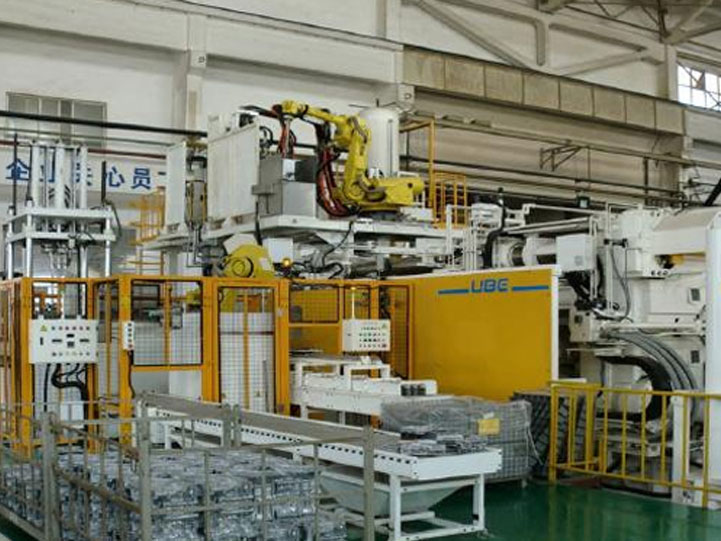What is Die Casting?
Die casting is a automated metal casting process in which molten metal is pushed under pressure (150 to 3600 bar) into a tightly closed metal die cavity and kept there by a powerful press until it hardens. After solidification of the metal, the die is unlocked, opened, and the casting ejected. After removal of the casting, the die is closed and locked again for the next cycle.
The advantages of this production process are that hundreds of thousands of die castings can be produced relatively quickly by using just one mold. All components produced by die casting have a uniform quality and involve high precision and relatively low unit costs.
The Definition Of Aluminum Die Casting
The aluminum alloy die-casting process uses high pressure to press the molten metal into a precision metal mold cavity at a high speed, and the molten metal cools and solidifies under the action of pressure to form aluminum alloy die-casting. Cold-chamber die-casting and hot-chamber die-casting are two basic methods of die-casting. In cold-chamber die-casting, molten metal is poured into the die-casting chamber by manual or automatic pouring devices, and then the injection punch advances to hydraulically press the metal into the cavity.
The China die casting process is the fastest option available for producing exact, non-ferrous metal products. Because this method utilizes reusable molds, it offers high-speed production of parts and has the flexibility to create a wider range of shapes and sizes than other casting methods.
Die casting can be completely automated, and its reusable molds also make it an affordable option. This technique is used to manufacture commercial, consumer, and industrial products. Die casting is ideal for medium-sized parts with more complex structures.
In the hot-chamber die-casting process, the pressure chamber is perpendicular to the crucible, and the molten metal automatically flows into the pressure chamber through the feed port on the pressure chamber. The injection punch moves downward, pushing the molten metal through the gooseneck into the cavity. After the molten metal solidifies, the die-casting mold is opened, the casting is taken out, and an aluminum alloy die-casting cycle is completed:
The first step is to debug the die casting machine. When debugging the die-casting machine, it is necessary to check whether the working state of the die-casting machine is normal, whether there are any loose parts, etc., to ensure that the die-casting machine will not have any problems during use.
In the second step, after debugging the die-casting machine, start to install the designed die-casting mold. The installation of the die-casting mold should be reliable and firm, and attention should also be paid to whether the die-casting mold is normal.
The third step is to preheat the mold. After the die-casting mold is installed, it must be preheated to prevent damage to the product due to thermal expansion and contraction.
The fourth step is pouring. This step involves injecting the material into the mold so that it can be shaped according to the mold’s pattern.
The fifth step is to maintain pressure. Since the material has not been fully formed at this time, it is necessary to maintain the pressure of the mold at this time to prevent the casting from going out of shape. After these five steps, the basic casting process of aluminum alloy die casting is completed.
Among them, the four basic processes of die-casting aluminum industry are annealing, normalizing, quenching and tempering. These four processes are called “four fires” in die-casting. In the die-casting process, the relationship between quenching and tempering Very close, both are indispensable.
According to Be-cu Rapid Prototyping Company’s knowledge from Longji Mould, who has rich experience in aluminum alloy die-casting, annealing is to heat the workpiece. When heated to an appropriate temperature, the die-casting part is slowly cooled according to the selected material, which has reached the The internal organization of the metal is close to the equilibrium situation.
Normalizing is to heat the workpiece to a suitable temperature and then cool it in the air. It is mainly used to improve the cutting performance of the material, and it can also be used to finish die casting for some parts with low demand.
Quenching is to rapidly cool the workpiece in a quenching medium such as water or other inorganic salt solutions after heating and keeping it warm. After this process, the produced steel will become hard and brittle. In order to reduce the brittleness of steel parts, the quenched steel parts can be placed at a temperature below 650 degrees Celsius and higher than normal temperature for a long time, and then cooled, which is called tempering.
China Die Casting Manufacturer For 80-3000t
As one of the best One-stop-service Prototyping and Manufacturing supplier in China, BE-CU.COM(China Pintejin Group) offers high quality die casting service to our customers. Our high-pressure die casting service can use materials including aluminum, zinc, magnesium and brass etc.
We have our own plant & facilities, and your die casting parts are manufactured with high quality and short lead time. Our excellent inspection and testing equipment ensures the quality of your finished parts, investment casting and sheet metal fabrication. We can take any project needs you may have.
You are welcome to take advantage of our comprehensive service at a reduced rate. Please do not hesitate to contact our engineering team for a free quote.we offer you an individual approach and the most cost-effective solution.
Media Contact
Company Name: Be-Cu Prototype Company | Pintejin Group
Email: Send Email
Phone: 15920677014
Address:Humen Sifang
City: Dongguan
State: Guangdong
Country: China
Website: https://be-cu.com/

